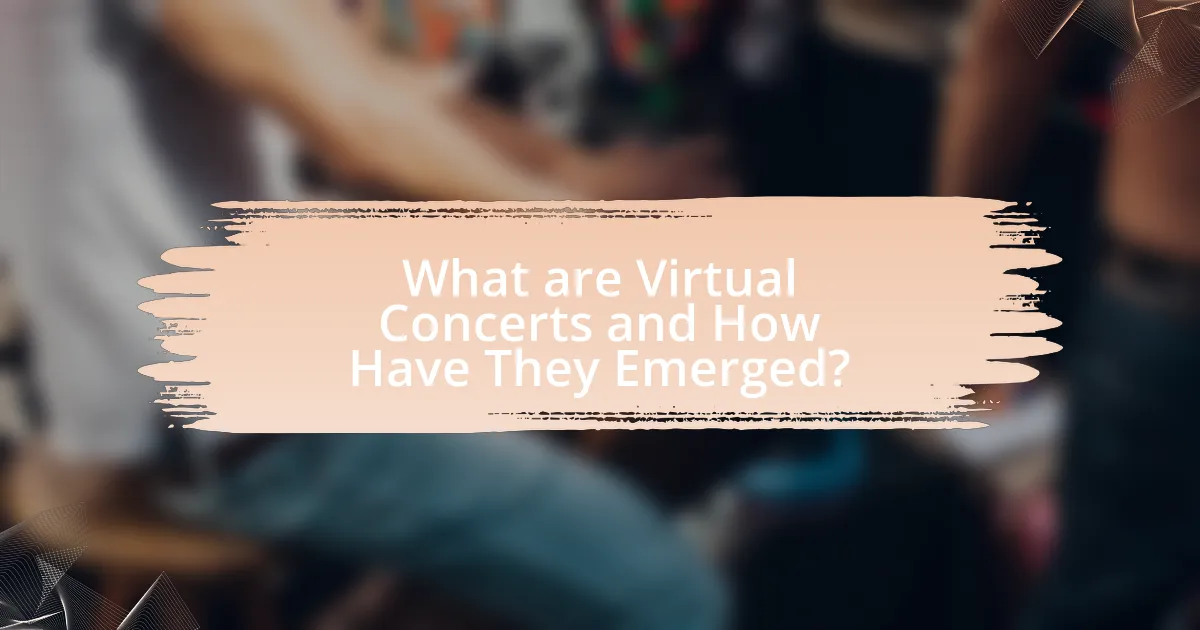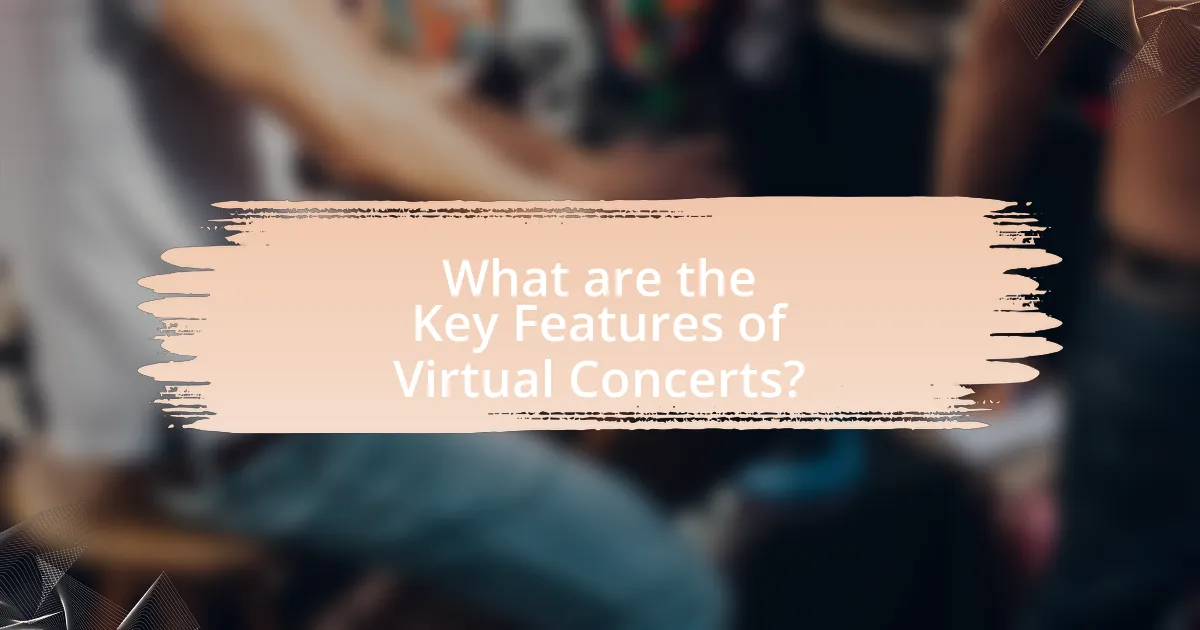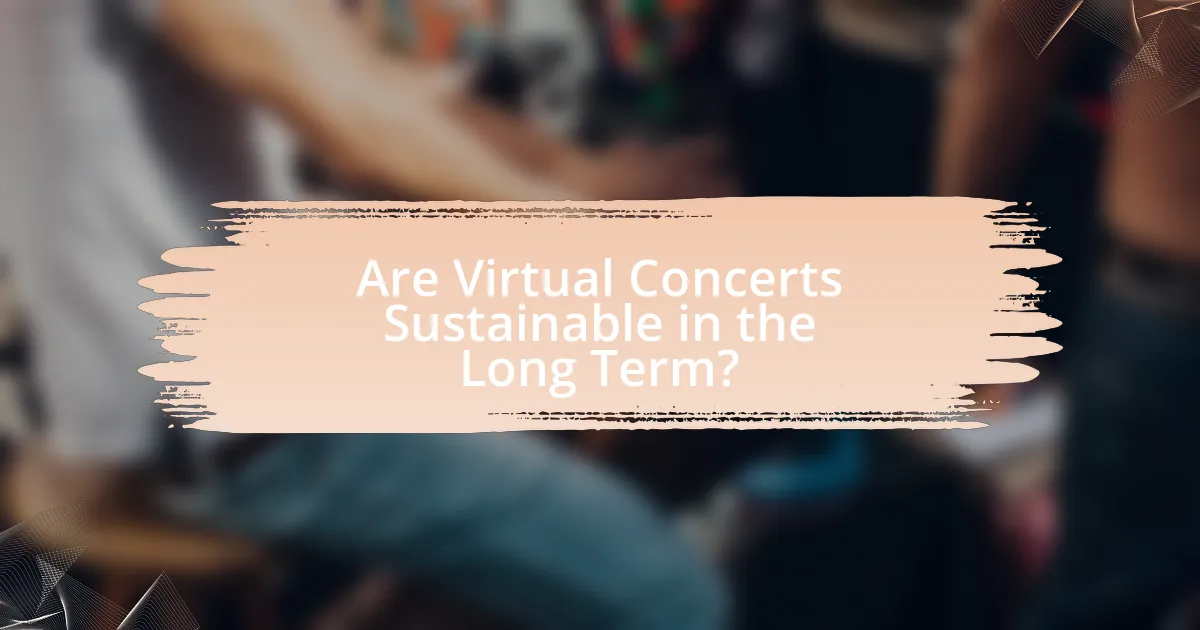Virtual concerts are live musical performances conducted in a digital environment, allowing audiences to participate remotely through streaming technology. Their emergence has been significantly influenced by advancements in internet connectivity and the social distancing measures necessitated by the COVID-19 pandemic. This article explores the definition of virtual concerts, their differences from traditional concerts, the technologies that enable them, and their growing popularity. It also examines the advantages of virtual concerts, the challenges they face, and the potential for sustainability in the long term, providing insights into how artists and fans can adapt to this evolving landscape.

What are Virtual Concerts and How Have They Emerged?
Virtual concerts are live musical performances that occur in a digital environment, allowing audiences to experience the event remotely through streaming technology. They have emerged significantly due to advancements in internet connectivity and the necessity for social distancing during the COVID-19 pandemic, which accelerated the adoption of virtual platforms for entertainment. For instance, in 2020, platforms like Twitch and YouTube hosted numerous virtual concerts, with artists such as Travis Scott attracting over 12 million viewers for his in-game concert in Fortnite, showcasing the potential reach and engagement of virtual events.
What defines a virtual concert?
A virtual concert is defined as a live musical performance that is broadcasted over the internet, allowing audiences to experience the event remotely. This format utilizes digital platforms and technologies, such as streaming services and social media, to reach viewers who can participate from various locations. The rise of virtual concerts has been significantly influenced by advancements in technology and the need for alternative entertainment options, particularly during events like the COVID-19 pandemic, which restricted in-person gatherings.
How do virtual concerts differ from traditional concerts?
Virtual concerts differ from traditional concerts primarily in their format and accessibility. Traditional concerts occur in physical venues where audiences gather in person, while virtual concerts are streamed online, allowing viewers to participate from anywhere with an internet connection. This shift to a digital platform has been accelerated by advancements in technology and the need for social distancing during events like the COVID-19 pandemic, which saw a significant increase in virtual performances. For instance, in 2020, platforms like Twitch and YouTube hosted numerous virtual concerts, reaching millions of viewers globally, demonstrating the potential for broader audience engagement compared to the limited capacity of physical venues.
What technologies enable virtual concerts?
Virtual concerts are enabled by technologies such as high-definition streaming, virtual reality (VR), augmented reality (AR), and interactive platforms. High-definition streaming allows audiences to experience live performances in real-time with minimal latency, enhancing engagement. VR creates immersive environments where users can feel as if they are physically present at the concert, while AR overlays digital elements onto the real world, enriching the visual experience. Interactive platforms, like social media and dedicated concert apps, facilitate audience participation through chat features, virtual meet-and-greets, and real-time feedback. These technologies collectively transform the concert experience, making it accessible to a global audience.
Why have virtual concerts gained popularity?
Virtual concerts have gained popularity primarily due to their accessibility and the ability to reach a global audience. The COVID-19 pandemic accelerated this trend, as physical gatherings were restricted, prompting artists to explore online platforms to connect with fans. For instance, a report by Pollstar indicated that virtual concerts generated over $100 million in revenue in 2020 alone, showcasing their financial viability. Additionally, platforms like Twitch and YouTube have facilitated interactive experiences, allowing fans to engage with artists in real-time, further enhancing the appeal of virtual performances.
What role did the COVID-19 pandemic play in the rise of virtual concerts?
The COVID-19 pandemic significantly accelerated the rise of virtual concerts by forcing artists and venues to adapt to social distancing measures and lockdowns. As live events were canceled globally, musicians turned to online platforms to reach their audiences, resulting in a surge of virtual performances. For instance, in 2020, platforms like Instagram Live, YouTube, and Twitch saw a dramatic increase in usage, with artists like Travis Scott hosting a virtual concert in Fortnite that attracted over 12 million viewers. This shift not only provided a new revenue stream for artists during a time of financial uncertainty but also expanded their reach to global audiences, demonstrating the viability of virtual concerts as an alternative to traditional live performances.
How do virtual concerts cater to a global audience?
Virtual concerts cater to a global audience by utilizing digital platforms that allow access from anywhere in the world. These concerts often feature live streaming technology, enabling fans to participate in real-time regardless of their geographical location. For instance, platforms like YouTube and Twitch have hosted major virtual events, attracting millions of viewers globally. Additionally, virtual concerts can be scheduled to accommodate various time zones, ensuring that audiences from different regions can enjoy the performances. The accessibility of these events is further enhanced by the ability to interact through chat features, creating a sense of community among fans worldwide.

What are the Key Features of Virtual Concerts?
Key features of virtual concerts include accessibility, interactivity, and immersive experiences. Accessibility allows audiences from around the world to attend without geographical limitations, as evidenced by platforms like YouTube and Twitch hosting large-scale events that attract millions of viewers. Interactivity enhances audience engagement through features such as live chats, polls, and virtual meet-and-greets, which have been utilized in events like Travis Scott’s Fortnite concert, drawing over 12 million participants. Immersive experiences are created using advanced technologies like augmented reality (AR) and virtual reality (VR), enabling fans to feel as though they are part of the performance, similar to the experiences offered by platforms like Oculus Venues. These features collectively contribute to the growing popularity and evolution of virtual concerts in the music industry.
What types of virtual concerts are available?
There are several types of virtual concerts available, including live-streamed concerts, pre-recorded performances, interactive concerts, and immersive experiences using virtual reality. Live-streamed concerts allow artists to perform in real-time for an online audience, often through platforms like YouTube or Twitch. Pre-recorded performances are edited videos of concerts that fans can watch at their convenience. Interactive concerts engage viewers by allowing them to participate in real-time through chat or polls, enhancing the experience. Immersive experiences utilize virtual reality technology to create a more engaging environment, allowing fans to feel as if they are part of the concert. These formats have gained popularity, especially during the COVID-19 pandemic, as artists and fans sought new ways to connect.
How do live-streamed concerts differ from pre-recorded performances?
Live-streamed concerts differ from pre-recorded performances primarily in their real-time interaction and immediacy. Live-streamed concerts allow audiences to engage with the artist and each other through live chat features, creating a communal experience, while pre-recorded performances lack this interactive element and are typically edited for quality and presentation. According to a 2021 survey by Eventbrite, 70% of respondents preferred live-streamed events for their ability to connect with performers in real-time, highlighting the unique appeal of live-streaming over pre-recorded formats.
What interactive elements are commonly included in virtual concerts?
Interactive elements commonly included in virtual concerts are live chat features, audience polls, and virtual meet-and-greets. Live chat allows viewers to communicate in real-time, enhancing engagement and creating a sense of community. Audience polls enable fans to vote on song selections or setlists, making them feel involved in the performance. Virtual meet-and-greets provide opportunities for fans to interact with artists through video calls or Q&A sessions, further personalizing the experience. These elements have been shown to increase viewer satisfaction and retention, as evidenced by platforms like Twitch and YouTube Live, which report higher engagement rates when such features are utilized.
What are the advantages of attending virtual concerts?
Attending virtual concerts offers several advantages, including accessibility, cost-effectiveness, and a unique interactive experience. Accessibility allows fans from various geographical locations to attend performances without travel barriers, as evidenced by the significant increase in online concert attendance during the COVID-19 pandemic, where platforms like YouTube and Twitch hosted millions of viewers globally. Cost-effectiveness is highlighted by reduced expenses associated with travel, accommodation, and ticket prices, making it more affordable for a wider audience. Additionally, virtual concerts often incorporate interactive features such as live chats and social media integration, enhancing audience engagement and creating a sense of community among fans, which has been shown to increase viewer satisfaction and participation rates.
How do virtual concerts enhance accessibility for fans?
Virtual concerts enhance accessibility for fans by allowing them to attend performances from anywhere in the world without geographical or physical barriers. This format enables individuals with disabilities, those living in remote areas, or fans unable to afford travel expenses to experience live music events. According to a 2021 report by the International Federation of the Phonographic Industry, virtual concerts have increased audience reach by over 50%, demonstrating their effectiveness in making live music more inclusive.
What cost benefits do virtual concerts offer compared to traditional events?
Virtual concerts offer significant cost benefits compared to traditional events, primarily through reduced overhead expenses. For instance, virtual concerts eliminate venue rental fees, which can range from thousands to millions of dollars, depending on the location and capacity. Additionally, costs associated with physical logistics, such as transportation, accommodation for artists and crew, and on-site staffing, are substantially lower or non-existent in a virtual format.
A study by the International Music Summit in 2021 highlighted that virtual events can achieve profit margins of up to 80% due to these reduced costs, compared to traditional concerts, which often operate at much lower margins due to high fixed expenses. Furthermore, virtual concerts can reach a global audience without the need for physical travel, maximizing ticket sales and minimizing marketing costs. This financial efficiency makes virtual concerts an attractive alternative for both artists and promoters.

Are Virtual Concerts Sustainable in the Long Term?
Virtual concerts are not inherently sustainable in the long term due to several factors. While they offer accessibility and lower production costs, the novelty may wear off as audiences return to in-person experiences. A study by the International Music Summit in 2021 indicated that 70% of music fans prefer live events over virtual ones, highlighting a potential decline in engagement for virtual formats. Additionally, the environmental impact of digital infrastructure and energy consumption for streaming raises questions about their long-term viability. Therefore, while virtual concerts can complement traditional events, their sustainability as a primary format remains uncertain.
What challenges do virtual concerts face moving forward?
Virtual concerts face several challenges moving forward, including technological limitations, audience engagement, and monetization issues. Technological limitations can hinder the quality of streaming, as inconsistent internet connections can lead to buffering and poor audio-visual experiences. Audience engagement is another challenge, as virtual formats often lack the immersive atmosphere of live events, making it difficult to replicate the emotional connection between performers and attendees. Additionally, monetization remains a significant hurdle; many artists struggle to generate revenue comparable to traditional concerts, as ticket sales and sponsorships may not be as lucrative in a virtual setting. These challenges must be addressed for virtual concerts to thrive in the future.
How do artists and promoters view the future of virtual concerts?
Artists and promoters view the future of virtual concerts as a significant and lasting component of the music industry. Many artists recognize the potential for virtual concerts to reach global audiences, as evidenced by the success of events like Travis Scott’s Fortnite concert, which attracted over 12 million viewers. Promoters also see virtual concerts as a way to diversify revenue streams, especially in light of challenges posed by live event restrictions during the COVID-19 pandemic. This shift is supported by a growing acceptance of digital experiences among fans, with a report from the International Music Summit indicating that 70% of music fans are open to attending virtual events in the future.
What technological advancements could impact the sustainability of virtual concerts?
Technological advancements such as improved streaming technology, virtual reality (VR), and artificial intelligence (AI) can significantly enhance the sustainability of virtual concerts. Enhanced streaming technology reduces bandwidth usage and improves audio-visual quality, making concerts more accessible and energy-efficient. VR creates immersive experiences that can replicate the atmosphere of live events without the carbon footprint associated with physical gatherings. AI can optimize resource management, such as energy consumption and audience engagement, leading to more sustainable event practices. For instance, a study by the International Energy Agency indicates that advancements in streaming efficiency can lower energy consumption by up to 30%, supporting the sustainability of virtual events.
How can artists and fans adapt to the evolving landscape of virtual concerts?
Artists can adapt to the evolving landscape of virtual concerts by leveraging technology to enhance audience engagement and create immersive experiences. For instance, artists can utilize high-quality streaming platforms and interactive features such as live chats, virtual meet-and-greets, and augmented reality elements to connect with fans in real-time. Fans can adapt by investing in better technology, such as high-definition screens and sound systems, to improve their viewing experience, and by participating in online communities to share experiences and connect with other fans. The rise of virtual concerts has been supported by a significant increase in online ticket sales, which reached $6.9 billion in 2021, indicating a strong market for this format.
What strategies can artists use to engage audiences during virtual performances?
Artists can engage audiences during virtual performances by utilizing interactive elements such as live Q&A sessions, polls, and chat features. These strategies foster real-time communication and create a sense of community among viewers. For instance, platforms like Twitch and YouTube Live allow artists to respond to audience comments and questions, enhancing viewer participation. Additionally, incorporating multimedia elements like visuals, behind-the-scenes content, and guest appearances can maintain audience interest and create a dynamic experience. Research indicates that interactive features significantly increase viewer retention and satisfaction, as evidenced by a study from the University of Southern California, which found that audiences are more likely to stay engaged when they can actively participate in the performance.
How can fans enhance their virtual concert experience?
Fans can enhance their virtual concert experience by actively engaging with the event through interactive features such as live chats, polls, and social media sharing. Engaging in these activities allows fans to connect with other attendees and the performers, creating a sense of community. Additionally, utilizing high-quality audio and video equipment can significantly improve the viewing experience, as studies show that sound quality directly impacts enjoyment levels during live performances. Furthermore, fans can personalize their experience by choosing optimal viewing angles and settings, which enhances immersion.
What are the best practices for hosting a successful virtual concert?
The best practices for hosting a successful virtual concert include ensuring high-quality audio and video, engaging with the audience through interactive features, and promoting the event effectively across multiple platforms. High-quality audio and video are crucial as they directly impact the viewer’s experience; studies show that 70% of viewers will leave a stream if the audio is poor. Engaging with the audience can be achieved through live chats, polls, and Q&A sessions, which foster a sense of community and connection. Effective promotion involves utilizing social media, email marketing, and collaborations with influencers to reach a wider audience, as events that are well-promoted can see attendance increase by up to 50%.